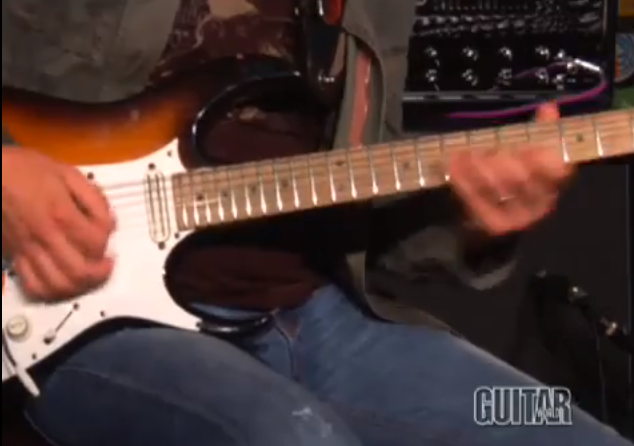Betcha Can't Play This: Building Suspense with Andy Timmons —Video

Here's a cool, suspenseful-sounding climbing run that’s based on the A minor pentatonic scale [A C D E G] and the A Dorian mode [A B C D E F s G].
The concept is to ascend the neck on just two strings—in this case the G and D—using a uniform alternate picking pattern applied to shifting positions.
What I’m essentially doing here is stringing together groups of 16th notes played in four-note shapes, or modules, and playing mostly two notes per string, with a couple of exceptions here and there wherein I stay on the G string and repeat the first two notes instead of crossing over to the D string.
Notice how the contour of the line climbs and falls—kind of like a statistics graph chart—as I ascend a couple of positions, take a step back and then continue ascending. I find this kind of ‘up two, back one’ or ‘up three, back one’ contour more interesting and dramatic than just a straight ascent. It also enables you to prolong a lick by not running out of fretboard as quickly.
One valuable thing about this approach, which I’ve worked on a lot, is that it helps you to learn scales up and down the neck, or horizontally, as opposed to just learning them vertically in separate positions. This way of playing and thinking can help you connect ‘blind spots’ and also enables you to maintain a consistent timbre by staying on the same strings throughout a run.
As is almost always the case when you’re playing any kind of fast lick like this, it’s important to try to use both hands to mute the strings you’re not playing on to suppress any sympathetic vibrations, which create noise that distortion unfortunately amplifies. The bass strings are best muted by lightly resting the palm of the picking hand on the bridge saddles as you pick the higher strings, while the treble strings may be muted with the fleshy side of the fret-hand fingers.
Equally important is that you resolve a lick smoothly. Notice here how I conclude the run with a bend and a hearty finger vibrato, which serves as the icing on the cake.
All the latest guitar news, interviews, lessons, reviews, deals and more, direct to your inbox!

Andy Timmons is a world-renowned guitarist known for his work with the Andy Timmons Band, as well as Danger Danger and Simon Phillips.

